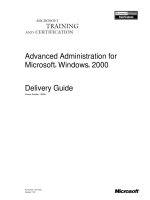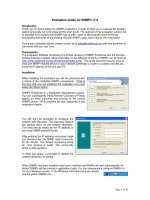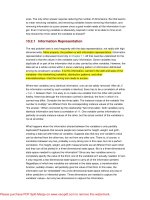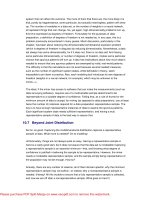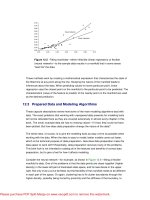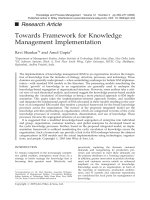Tài liệu IELTS Guide for Stakeholders March 2009 ppt
Bạn đang xem bản rút gọn của tài liệu. Xem và tải ngay bản đầy đủ của tài liệu tại đây (598.42 KB, 16 trang )
Guide
for educational institutions, governments,
professional bodies and commercial organisations
International English Language Testing System
IELTS – the International English Language Testing System – serves
educational institutions, governments, professional bodies and
commercial organisations around the world. It helps you recruit
applicants who are able to communicate effectively in English.
Wherever you are based, our high-quality, practical and secure test
ensures you only take on people who can actively engage in all
aspects of work, study and training.
Over one million people take the IELTS test
each year. Selecting applicants with the right
level of English has never been easier.
2 IELTS Guide
IELTS Guide 3
Global recognition
IELTS is already trusted and used by over 6,000 institutions worldwide, including universities,
employers, professional bodies and immigration authorities. It is the test that sets the standard
around the world.
Accessible and convenient
IELTS is one of the most widely available English language tests in the world. It is offered up to
four times a month in more than 125 countries. Our test centres have a greater testing capacity
than most other tests. For a full list of IELTS centres worldwide, visit www.ielts.org
The cost of taking the test is set locally, payable in local currency. This makes IELTS accessible
to all candidates, wherever they take the test.
The international test
• Almost all universities in Australia, Canada, New Zealand and the
UK accept IELTS.
• In the USA, IELTS is accepted by over 2,000 universities, colleges
and faculties, including Ivy League and other top institutions.
• IELTS is used for immigration to Australia, Canada, New Zealand
and the UK.
• Employers in English-speaking countries and beyond accept
IELTS scores.
• Professional bodies and training bodies in areas such as law and
medicine use IELTS.
The effectiveness of IELTS has been proven since 1989. Leading experts in language assessment
have designed the test to be fair, accurate and relevant wherever and whenever it is taken.
Face-to-face speaking assessment
The most effective way to assess speaking skills is through direct interaction with the test taker.
We want to judge their ability to communicate in a real-life situation, not just respond to recorded
prompts. That is why trained examiners conduct a face-to-face assessment with each IELTS
candidate individually. The face-to-face Speaking assessment remains an essential part of IELTS,
setting it apart from other English language tests.
Continual research-driven improvement
IELTS is at the cutting edge of English language testing. Our approach to test design, delivery and
evaluation is constantly refined to incorporate advances in applied linguistics, language pedagogy,
language assessment and technology. The steady evolution of IELTS in response to such advances
has ensured its contemporary relevance and continued usefulness for all test stakeholders.
Although IELTS has benefited from decades of progressive change, we have always maintained
our core commitment to assessing all four language skills – reading, writing, listening and
speaking – to the highest of standards.
4 IELTS Guide
The quality test
Fit for purpose
The IELTS test has been designed by world leaders in language assessment in close consultation
with academics, professional bodies and immigration authorities. It is backed by an extensive
programme of world-class research and validation. The test is continually developed to take into
consideration the needs of all users and to ensure it is truly fit for purpose. As a result, there are
two different test modules – Academic and General Training. This makes IELTS directly relevant
and appealing to a wide range of test users.
The test content is also internationally focused, thanks to our network of test materials writers in
the USA, Australia, New Zealand and the UK. We use a range of native-speaker accents in the
Listening component (North American, Australian, New Zealand and British English), and all the
standard varieties of English are accepted in candidates’ responses.
The truly international nature of IELTS makes it the preferred choice of candidates and
institutions worldwide.
Expert raters
Candidate performances in the Writing and Speaking components are assessed by qualified
examiners rather than computers. This provides a more reliable assessment of real-world
communication skills.
Examiners are recruited, trained and monitored in line with the highest quality standards.
They work to clearly defined criteria and are subject to extensive and detailed quality control
procedures which ensure consistency in assessment no matter where the test is taken in the
world. Examiners are required to demonstrate that they are rating to standard every two years,
in addition to regular ongoing monitoring and standardisation of their performance.
A similarly rigorous recruitment, training and monitoring system is in place for the markers of
the Listening and Reading components. The reliability of marking is also enhanced by the
double-marking of a proportion of Listening and Reading answer sheets at every test session.
Production of test materials
Every test version is unique, so no candidate will ever receive the same test paper twice.
The production of IELTS involves an extensive and scrupulous process. We use the highest
qualitative standards as well as quantitative statistical data to ensure that test materials are
suitable and test to the same level of difficulty every time.
As part of the production process, writers in the USA, Australia, New Zealand and the UK
are commissioned to provide test materials which are then measured against quality standards.
These test materials are subjected to rigorous editing procedures and are trialled on
representative groups of test takers to ensure that they are appropriately challenging and that
they discriminate between more and less able candidates.
IELTS Guide 5
Test results you can trust
IELTS test results are used for admission to universities, colleges and professions, as well as for
immigration to English-speaking countries. For this reason it is essential to ensure the security
of candidate results. IELTS has a number of measures in place to safeguard against the
falsification of results.
Test Report Forms are printed on security-enhanced paper. They are authenticated by a centre
stamp, an IELTS validation stamp and a photograph of the candidate.
Test centre security
All IELTS test centres are required to follow a detailed code of practice which ensures the
highest standards of security throughout the testing process, from registration to the recording
of results. Candidates must provide photographic evidence of identity when they register and
on the day of the test. In addition, every IELTS test centre administrator is trained to the level of
immigration officials in order to ensure they can detect impostors and fraudulent documents.
Test Report Form Online Verification Service
The authenticity of any Test Report Form (TRF) you receive from applicants can be checked by
using our free TRF Online Verification Service. This secure and easy-to-use feature is an
invaluable tool for verifying test results. If you would like more information or to register for the
free TRF Online Verification Service, visit www.ielts.org/trf
6 IELTS Guide
Test Report Forms issued in England and Wales
Please note that IELTS is accredited in the UK by the
government’s examinations regulator for England and Wales,
Ofqual. As a condition of this accreditation, the information
printed on the back of IELTS Test Report Forms issued in
England and Wales is different from the information given on
forms issued elsewhere in the world. For more information see
www.ielts.org
Increasing your efficiency
IELTS results are issued to candidates just 13 days after
they take the test. Centres can send Test Report Forms to
you directly, so you can trust the results you receive.
Electronic downloads
In order to simplify the processing of applications and to make the verification of
results more convenient, you can download the results of all candidates applying to your
institution on a single file. This eliminates the need for you to process Test Report Forms
individually. It also allows you to receive results faster and transfer them directly to your data
system. Our free E-downloads service is available to all registered organisations that recognise
IELTS scores. It is the most secure, practical and efficient way to receive results. To find out
more about our free E-downloads service, contact us at
IELTS Guide 7
Test scores
IELTS provides a profile of a candidate’s ability to use English.
Results are reported as band scores, on a scale from 1 (the lowest) to 9 (the highest), as shown.
Candidates receive an overall band score as well as individual scores for each test component
(Listening, Reading, Writing and Speaking).
Using IELTS test scores
The level of English needed for a candidate to perform effectively in study, work or training
varies from one situation to another. That is why each individual organisation can set its own
minimum IELTS score for applicants, depending on specific requirements.
Organisations using IELTS may consider the overall band score as well as the individual scores
recorded for the four components of the test. These indicate a candidate’s particular strengths
and weaknesses and allow you to assess their suitability for a specific situation. For example,
if the candidate is applying for a course that has a lot of reading and writing assignments but
no lectures, the Listening score may not be as important as the Reading and Writing scores.
The table below gives guidance on acceptable IELTS scores for different courses. It should be
noted, however, that many diverse variables can affect performance on courses, of which
language ability is but one.
IELTS Band Scores
9 Expert user
8 Very good user
7 Good user
6 Competent user
5 Modest user
4 Limited user
3 Extremely limited user
2 Intermittent user
1 Non user
0 Did not attempt the test
8 IELTS Guide
The appropriate level for entry to your institution is something that you decide. We will, however,
provide any advice and assistance you may need.
Guidance on setting appropriate band score requirements is provided in the ‘IELTS Scores
Explained’ DVD (available from www.ielts.org). The DVD also contains detailed descriptions of
the test components, sample test materials and examples of candidates’ writing and speaking
performances at different band levels.
Test results validity period
The IELTS test provides an accurate picture of a candidate’s language skills at a given moment.
For this reason, the validity of a score as a precise representation of a candidate’s abilities will
inevitably diminish in time. As a rule, we recommend that a Test Report Form which is more than
two years old should only be accepted if it is accompanied by proof that a candidate has
actively maintained or tried to improve their English.
Band
Linguistically
demanding
academic courses
e.g. Medicine, Law,
Linguistics,
Journalism
Linguistically less
demanding
academic courses
e.g. Agriculture,
Pure Mathematics,
Technology, IT and
Telecommunications
Linguistically
demanding training
courses
e.g. Air Traffic
Control, Engineering,
Pure/Applied
Sciences, Industrial
Safety
Linguistically less
demanding training
courses
e.g. Catering, Fire
Services
7.5 – 9.0 Acceptable Acceptable Acceptable Acceptable
7.0 Probably acceptable Acceptable Acceptable Acceptable
6.5 English study needed Probably acceptable Acceptable Acceptable
6.0 English study needed English study needed Probably acceptable Acceptable
5.5 English study needed English study needed English study needed Probably acceptable
IELTS Guide 9
To cater for the specific language requirements of different institutions, IELTS comes in two
modules – Academic and General Training.
Both the Academic and General Training modules cover the four language skills – listening, reading,
writing and speaking. All candidates take the same Listening and Speaking components. There are
different Reading and Writing components for the Academic and General Training modules.
Academic and General Training modules
Both modules are graded using exactly the same criteria, so there is no difference in the level
of English. The distinction lies in the subject matter and type of vocabulary used. The General
Training module is not designed to test the full range of formal language skills required for
academic purposes.
The Academic module is for candidates wishing to study at undergraduate or postgraduate
levels, and for those seeking professional registration.
The General Training module is for candidates wishing to migrate to an English-speaking
country (Australia, Canada, New Zealand, UK), and for those wishing to train or study at
below degree level.
What does the test involve?
Speaking
Time: 11–14 minutes
Academic Reading
Time: 60 minutes
General Training Reading
Time: 60 minutes
Listening
Time: approximately 30 minutes
Academic Writing
Time: 60 minutes
General Training Writing
Time: 60 minutes
10 IELTS Guide
IELTS Guide 11
Questions 27 – 30
Choose the correct letter, A, B or C.
27 Why does Harry want to
do the presentation?
A to practise skills for his future career
B to catch up with his course requirements
C to get a better m
ark than for his la
st presentation
28 What is Katy’s attitude to writing up the project?
A She is worried about the time available for writing.
B She thinks it is unfair if she has to do all the writing.
C She is concerned that som
e parts will be diff
icult.
29 Why does Harry want to involve the other students at the end of the presentation?
A to get their opinions about the conclusions
B to help him and Katy reach firm
con
clusions
C to see if they have reached similar conclusions
30 Katy agrees to deal with any questions because
A she feels she will be confident about the material.
B Harry will be doing the main presentation.
C she has already told Dr Sm
ith she will do thi
s.
SECTION 3 Questions 21 – 30
Questions 21 and 22
Complete the sentences below.
Write NO MORE THAN TWO WORDS for each answer.
Environmental Project
x
Harry and Katy have to concentrate on coastal change for their next project.
21 Their work could be delayed by the ………………… .
x
They plan to get help from the Marine Biology Unit.
22 Before they go to the beach, they need to visit the ………………… .
Questions 23 – 26
Who will do each of the following tasks?
A Katy
B Harry
C Both Katy and Harry
Write the correct letter, A, B or C, next to questions 23-26.
Tasks
23 take photographs ………
24 collect samples ………
25 interview people ………
26 analyse data ………
Listening
The Listening component takes around 30 minutes to complete. There are 40 questions in four
sections. A variety of question types is used in order to test a wide range of listening skills.
These include ability to understand main ideas and detailed factual information, ability to
understand the opinions and attitudes of speakers, ability to understand the purpose of an
utterance and ability to follow the development of ideas.
The first two sections deal with situations set in everyday social contexts. There is a conversation
between two speakers in Section 1 and a monologue in Section 2.
The final two sections deal with situations set in educational or training contexts. In Section 3,
there is a conversation between up to four speakers (for example, between a university tutor
and some students), and Section 4 is a monologue on an academic subject.
There is a range of native-speaker accents in the recordings, which reflects the international
nature of IELTS.
Listening Task Section 3 (example)
The four test components
Reading
The Reading component takes 60 minutes to complete. There are 40 questions in three sections.
A variety of question types is used in order to test a wide range of reading skills. These include
reading for gist, reading for main ideas, reading for detail, skim reading, understanding detailed
logical argument, recognising writers’ opinions, attitudes and inferences.
Academic Reading
The Academic Reading test includes three long texts (between 750 and 950 words each) which
range from the descriptive and factual to the discursive and analytical. The texts are authentic
and are taken from books, journals, magazines and newspapers. They are accessible to a
non-specialist audience but are recognisably appropriate for candidates entering undergraduate
or postgraduate courses or seeking professional registration.
General Training Reading
The General Training Reading component contains one long narrative or descriptive text and
several shorter, more factual, texts. The texts are authentic and are taken from books, magazines,
notices, advertisements, company handbooks and guidelines. Texts are based on the type of
written material candidates are likely to encounter on a daily basis in an English-speaking
country.
8 IELTS Guide
Questions 21 – 26
Complete the flow-chart below.
Choose NO MORE THAN TWO WORDS from the text for each answer.
Write your answers in boxes 21-26 on your answer sheet.
Air Flight Attendants – Recruitment and Training Process
Candidates go online to complete their 21 ………… .
Suitable candidates are then invited to come to a 22 ………… .
After having satisfactorily completed a 23 ………… , successful
candidates will then go to the Assessment Centre.
The airline then asks for 24 ………… , and candidates are required to
undergo a medical check.
If there is no immediate need for flight attendants, successful candidates
are put into a 25 ………… .
When the need arises, these candidates will then be given
a 26 ………… , after which they may be offered a job.
On starting the job, a five-week training programme is provided which
includes how to look after passengers and what to do in an emergency.
Questions 33 – 36
Complete the summary using the list of words, A-K, below.
Write the correct letter, A-K, in boxes 33-36 on your answer sheet.
Respondents to the survey mentioned several factors they think reduce 33
in engineering design and thus innovation. Among them were the development costs
associated with high-tech products, globalisation and 34 justified on safety
grounds, all of which inhibit the freedom of designers to design. The trend towards
inter-company 35 on the subject of, for example, patents gives further cause
for concern. On the other hand, some respondents deny that there is any great
problem, welcoming an improved system of 36 . For this reason, there is,
these respondents argue, the possibility that innovation is on the increase. Certainly,
they would not be surprised if that was so.
A excellence B standards C production
D diversity E communication F regulations
G disputes H specifications I agreements
J selection K rivalries
Questions 37 – 40
Do the following statements agree with the views of the writer in Reading Passage 3?
In boxes 37-40 on your answer sheet, write
YES if the statement agrees with the views of the writer
NO if the statement contradicts the views of the writer
NOT GIVEN if it is impossible to say what the writer thinks about this
37 It is debatable whether levels of innovation are increasing or decreasing.
38 Governments can exert an unhelpful influence on innovation.
39 The focus of industry on older technologies gives the impression of declining
innovation.
40 In the case of older technologies, feedback is of little importance.
General Training Reading (example)
Academic Reading (example)
12 IELTS Guide
IELTS Guide 13
Writing
The Writing component takes 60 minutes to complete and consists of two tasks. Task 1 requires
candidates to write at least 150 words and Task 2 requires candidates to write at least 250 words.
For both tasks, candidates need to demonstrate their ability to write a response which is appropriate
in terms of content, vocabulary and the organisation of ideas.
Academic Writing
In Task 1, candidates are presented with a graph, table, chart or diagram. They are asked to
describe, summarise or explain the information in their own words. They may be asked to
describe and explain data, describe the stages of a process, how something works or describe
an object or event.
In Task 2, candidates are asked to write an essay in response to a point of view, argument
or problem.
Candidates are required to write in a formal style for both tasks.
General Training Writing
In Task 1, candidates are presented with a situation and asked to write a letter requesting
information or explaining the situation. The letter may be personal, semi-formal or formal in style.
In Task 2, candidates are asked to write an essay in response to a point of view, argument or
problem. The essay may be formal in style but the response may be slightly more personal than
in Academic Writing Task 2.
WRITING TASK 1
You should spend about 20 minutes on this task.
You are interested in doing a computer course at your local college.
Write a letter to the college. In your letter
• explain why you want to do this course
• give information about your educational background and computer
skills
• ask some questions about the course
Write at least 150 words.
You do NOT need to write any addresses.
Begin your letter as follows:
Dear Sir or Madam,
Academic Writing Task 1 (example)
General Training Writing Task 1 (example)
Speaking
The Speaking component takes between 11 and 14 minutes to complete. Every IELTS
candidate has a face-to-face oral interview with an examiner. The Speaking test is recorded.
There are three parts to the Speaking component.
In Part 1, candidates answer general questions about themselves and a range of familiar topics,
such as their home, family, work, studies and interests. This part lasts between 4 and 5 minutes.
In Part 2, candidates are given a card which asks them to talk about a particular topic. They
have 1 minute to prepare before speaking for up to 2 minutes. The examiner then asks one or
two questions on the same topic to finish this part of the test.
In Part 3, candidates are asked further questions which are connected to the topic of Part 2.
These questions give the candidate an opportunity to discuss more abstract issues and ideas.
This part lasts between 4 and 5 minutes .
Example Part 3 (extract)
Let’s consider first of all animals and conservation …
• In your opinion, what are the advantages and disadvantages of keeping animals in zoos?
Why?
• Apart from keeping animals in zoos, how do you think humans can protect animals from
extinction?
• Some people think that governments should spend more money on helping human beings
rather than trying to protect animals? Do you agree? Why?
Example Part 2 task
Candidate task card:
Describe a teacher who has greatly influenced you in your education.
You should say:
where you met them
what subject they taught
what was special about them
and explain why this person influenced you so much.
You will have to talk about the topic for 1 to 2 minutes.
You have 1 minute to think about what you are going to say.
You can make some notes to help you if you wish.
14 IELTS Guide
Speaking Test Part 3 (example)
Speaking Test Part 2 (example)
Candidates with special requirements
Test centres make every effort to cater for candidates with special requirements. It is our aim
that the language level of all candidates should be assessed fairly and objectively. Modified
versions of the test are available for candidates with visual or hearing difficulties. Special
administrative arrangements can also be made to accommodate candidates with other
difficulties, e.g. dyslexia. Full details of our comprehensive service for candidates with special
requirements are given on www.ielts.org
Why IELTS?
• The original four-skills test that assesses real communication skills.
• Trusted by over 6,000 institutions worldwide.
• Proven to be fit for purpose since 1989.
• Guaranteed security with our unique Test Report Form Online Verification Service and
a host of other security features.
How can IELTS help you?
• Relieve your institution of all the administration and cost involved in English language testing.
• Select candidates who already meet your English language requirements.
• Gain access to ongoing support from some of the world’s leading language assessment
experts.
• Provide your applicants with a clearer understanding of the level of English they need.
• Process applications more efficiently – with quick, easy and direct access to verifiable results.
Next steps
Take advantage of all the benefits offered by IELTS in three simple steps:
We will then include you on our online global database, giving your organisation even greater
exposure to millions of potential candidates worldwide.
Set a minimum IELTS score for your applicants. Use the ‘IELTS Scores Explained’ DVD
or contact us for advice.
Include the minimum score in your recruitment
and publicity literature.
Register your institution with us free of charge by completing the online form
at
IELTS Guide 15
IELTS is jointly managed by British Council, University of Cambridge ESOL Examinations (Cambridge ESOL)
and IDP: IELTS Australia. The IELTS test is designed and set by some of the world’s leading experts in language
assessment to give a true picture of a candidate’s language skills.
University of Cambridge
ESOL Examinations
1 Hills Road
Cambridge, CB1 2EU
United Kingdom
Tel 44 1223 553355
Fax 44 1223 460278
British Council
Bridgewater House
58 Whitworth Street
Manchester, M1 6BB
United Kingdom
Tel 44 161 957 7755
Fax 44 161 957 7762
IDP: IELTS Australia
GPO Box 2006
Canberra
ACT 2601
Australia
Tel 61 2 6285 8222
Fax 61 2 6285 3233
IELTS International
825 Colorado Boulevard
Suite 112
Los Angeles
CA 90041
USA
Tel 1 323 255 2771
Fax 1 323 255 1261
www.ielts.org
*0976898303*
© UCLES 2009 | EMC/5622/9Y03

